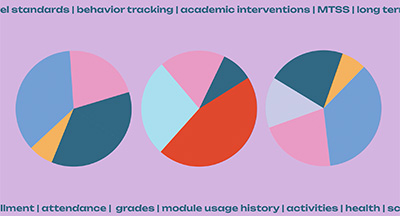
This article originally appeared at District Administration.
One of the trickiest parts of keeping teachers in classrooms is the wild card of student behavior. Misbehavior is one of the biggest thorns in the side of administrators, teachers, parents, and even peers in the classroom. Months of uncertainty and isolation behind screens didn’t do developing kids any favors when it comes to social-emotional learning. The problem is well understood. The solution is less than straightforward.
Kids need to learn, even when their classroom behavior is undesirable. But no teacher signs up to be, in the clear-as-crystal words of Ellen the maid from Mary Poppins, “a ruddy zookeeper.” As administrators grapple with the ballooning behavior disaster, one steadfast supporter waits quietly in the wings: data.
Enlist SIS tools to inform intervention or prevention
Behavioral intervention is strengthened by data, and data is hard to come by when documentation is time-consuming and manual. When staff can use a student information system built to manage behavior tracking, it makes documenting non-escalated referrals easier. Behavior incidents are visible to administrators and parents. Best of all, data is effective because it can be analyzed to find trends, displayed on a dashboard, and securely shared.How to and what to track in an SIS
First, educator teams must decide:What do I need to know?
How am I going to find out?
What question or hypothesis are you curious about or trying to measure? Where will the data come from? Big questions require lots of reliable data to make a sound decision. Luckily, this is a win-win for admin and staff alike.
The data required to make big decisions about behavior initiatives, SEL, and multi-tiered systems of support (MTSS) all require a team effort in keeping documentation. This type of communication is less cumbersome when it can happen on a web-based SIS that automatically flows data to relevant parties. While not every infraction needs a referral to the office, every infraction that can be tracked and analyzed helps narrow down MTSS decisions. Well-implemented MTSS not only helps coach student behavior, it makes them feel heard. After all, behavior is communication and it serves a purpose for students—even if it results in disruption for the rest of the class.
Data is only useful if it’s effective for decision-making, which requires examining data to find patterns that can be improved with intervention and prevention.
Using SIS data to make decisions
In School-Based Behavioral Assessment, Second Edition, authors Sandra M. Chafouleas et. al., identify four types of data decisions educators can make using high-quality behavior data:Evaluation data is a general summary of behavior over time. It gives insight into overall effectiveness between specific time points. This is a set of high-level data scaled to larger groups. Administrators would use district- or school-wide data to uncover trends.
Diagnosis data is based on students’ identified and documented needs. This set of data about an individual makes meeting needs more efficient since there are criteria used instead of guessing.
Screening data is used to identify whether students are at risk. They’re usually already having a hard time (perhaps the behavior incidents are adding up). This type of data goes hand in hand with academic screening data to identify students who need academic and behavioral intervention. Screening is efficient and systemic to quickly identify students before they stray too far from grade-level expectations.
Finally, progress monitoring data is collected frequently and repetitively, sometimes at specific benchmarks or milestones. This type of data is analyzed to determine if students are meeting or proceeding toward goals. Progress monitoring can also provide insight into whether specific school- or district-wide initiatives or programs are effective. Chafouleas, et. al., describe behavior management decision-making this way:
“We then implement a change, such as an intervention, while continuing to collect data to evaluate if the data that we observe are different from the data we predicted we’d see” (School-Based Behavioral Assessment, Second Edition, p. 15).

An SIS provides the data experts use to gain insight
It’s crucial to point out that the data is simply the map educators use to study trends and make decisions. Every student needs expert coaches to make decisions about their unique education path—and that’s a huge undertaking. An SIS simply provides a high-powered tool to make gathering, keeping, and analyzing that data a little easier.Learn more about behavior management in your SIS.
WHAT'S NEXT FOR YOUR EDTECH? The right combo of tools & support retains staff and serves students better. We'd love to help. Visit skyward.com/get-started to learn more.

|
Erin Pinter Edtech Thought Leader |




